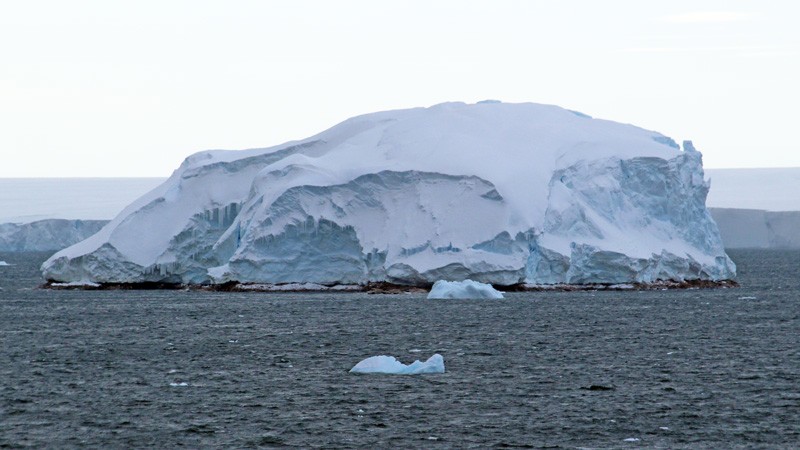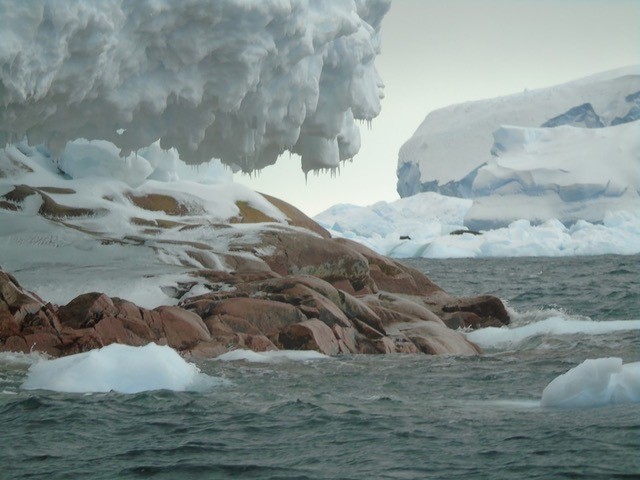Researchers first spotted this rocky outcrop in Pine Island Bay, West Antarctica, in early February.
A mate on the bridge spotted some rocky coastline. This island is on no charts : we call it Sif.
A mate on the bridge spotted some rocky coastline. This island is on no charts : we call it Sif.
Credit: Gui Bortolotto
From Nature
An uncharted island off Antarctica’s western coast could reveal how climate change is altering the continent.
A scientific expedition off the coast of Antarctica earlier this month spotted an island that appears on no maps — a finding that demonstrates how quickly the continent is changing as a result of climate change.
“I think I see rocks,” shouted an officer aboard the RV Nathaniel B. Palmer as the ship passed through Pine Island Bay, Antarctica.
After consulting their charts, the crew realized they were looking at a brand-new island.
There was a commotion as everyone onboard rushed to see the rocky, ice-covered outcrop and suggest potential names.
But the hubbub quickly gave way to excitement about the scientific implications of the find, says Julia Wellner, a marine geologist at the University of Houston in Texas.
Wellner is one of the principal investigators of the Thwaites Glacier Offshore Research project, part of an international collaboration to study the stability of a massive glacier in West Antarctica.
An expedition to collect samples from the exposed shoreline has thus far been hampered by bad weather, but Wellner says that surveying the island is one of the science team’s top priorities.
Although the island is big enough to be visible by satellite, its icy cap helped it escape previous detection.
And because very few ships travel that far south, Wellner’s team is probably the first to set eyes on it.
Researchers don’t yet know how long it has been above sea level, but it is likely that the land was exposed thanks to climate change.
On the rebound
As glaciers have retreated in West Antarctica, they have released pressure on Earth’s crust, allowing it to rebound and rise, explains Lindsay Prothro, a glacial geologist at Texas A&M University–Corpus Christi.
Collecting samples from the new island could help researchers determine how fast the continent is lifting, which should improve how they model the behaviour of nearby glaciers.
Rapid rebound could increase stress on the remaining ice sheet, causing it to break apart more quickly, says Lauren Simkins, a glacial geologist at the University of Virginia in Charlottesville.
But a rising continental shelf could also anchor glaciers, increasing their stability and slowing their march to the sea.
The island, Simkins says, could provide a nice real-world case study.
New islands have appeared over the past few years in the Canadian Arctic and Greenland.
But it is, he says, an exciting opportunity to piece together the geological history of a vastly under-studied region of Earth.
It will be more than a month before even preliminary results emerge: the Palmer is not due back in port until 25 March.
But glacier scientists are excited about the possibilities that the discovery raises for their field.
“This one island could hold a lot of clues,” Simkins says
Links :
From Nature
An uncharted island off Antarctica’s western coast could reveal how climate change is altering the continent.
A scientific expedition off the coast of Antarctica earlier this month spotted an island that appears on no maps — a finding that demonstrates how quickly the continent is changing as a result of climate change.
“I think I see rocks,” shouted an officer aboard the RV Nathaniel B. Palmer as the ship passed through Pine Island Bay, Antarctica.
After consulting their charts, the crew realized they were looking at a brand-new island.
There was a commotion as everyone onboard rushed to see the rocky, ice-covered outcrop and suggest potential names.
But the hubbub quickly gave way to excitement about the scientific implications of the find, says Julia Wellner, a marine geologist at the University of Houston in Texas.
The island was sighted from Nathaniel B. Palmer, currently in the Antarctic for
@GlacierThwaites THOR, project leads Julia Wellner (UH) and Rob Larter (BAS).
@GlacierThwaites THOR, project leads Julia Wellner (UH) and Rob Larter (BAS).
Photo_CD Hillenbrand (BAS)
Wellner is one of the principal investigators of the Thwaites Glacier Offshore Research project, part of an international collaboration to study the stability of a massive glacier in West Antarctica.
An expedition to collect samples from the exposed shoreline has thus far been hampered by bad weather, but Wellner says that surveying the island is one of the science team’s top priorities.
Although the island is big enough to be visible by satellite, its icy cap helped it escape previous detection.
And because very few ships travel that far south, Wellner’s team is probably the first to set eyes on it.
Researchers don’t yet know how long it has been above sea level, but it is likely that the land was exposed thanks to climate change.
Pine Island Bay with the GeoGarage platform (NGA nautical raster chart)
On the rebound
As glaciers have retreated in West Antarctica, they have released pressure on Earth’s crust, allowing it to rebound and rise, explains Lindsay Prothro, a glacial geologist at Texas A&M University–Corpus Christi.
Collecting samples from the new island could help researchers determine how fast the continent is lifting, which should improve how they model the behaviour of nearby glaciers.
Rapid rebound could increase stress on the remaining ice sheet, causing it to break apart more quickly, says Lauren Simkins, a glacial geologist at the University of Virginia in Charlottesville.
But a rising continental shelf could also anchor glaciers, increasing their stability and slowing their march to the sea.
The island, Simkins says, could provide a nice real-world case study.
New islands emerging as ice sheets retreat is not particularly surprising, says Paul Cutler, a programme director in glaciology at the US National Science Foundation in Alexandria, Virginia.Looks like ice retreated from the new "Sif Island" near #ThwaitesGlacier, #Antarctica since the early 2010s, based on a quick look at @googleearth timelapse.@ThwaitesGlacier @GlacierThwaites @rdlarter https://t.co/mt1E0QBEkk pic.twitter.com/UQr1hppukL— Peter Neff (@peter_neff) February 24, 2020
New islands have appeared over the past few years in the Canadian Arctic and Greenland.
But it is, he says, an exciting opportunity to piece together the geological history of a vastly under-studied region of Earth.
It will be more than a month before even preliminary results emerge: the Palmer is not due back in port until 25 March.
But glacier scientists are excited about the possibilities that the discovery raises for their field.
“This one island could hold a lot of clues,” Simkins says
Links :



DailyMail :
ReplyDeleteHidden island the size of Windsor Castle is uncovered in Antarctica after melting glaciers caused by record high temperatures reveal its rocky shore